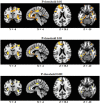Brain structural alterations in autism and criminal psychopathy
- PMID: 35872437
- PMCID: PMC9421457
- DOI: 10.1016/j.nicl.2022.103116
Brain structural alterations in autism and criminal psychopathy
Abstract
The goal of this study was to elucidate the anatomical brain basis of social cognition through two disorders with distinctively different phenotypes of social interaction. We compared structural MR images of 20 individuals with autism spectrum disorder (ASD), 19 violent offenders with high psychopathic traits, and 19 control participants using voxel-based morphometry (VBM). Our earlier study showed lower grey matter volume (GMV) values in the insula, frontal cortex, and sensorimotor cortex of the offender group compared to controls. In the present study, the images of the ASD group revealed lower GMV in the left precuneus, right cerebellum, and right precentral gyrus in comparison with controls. The comparison between the offender and ASD groups showed lower GMV values for the right temporal pole and left inferior frontal gyrus in the offender group. There was also an overlap of both disorders in the right pre-central cortex, showing lower GMV compared to controls. Our findings suggest structural differences between violent offenders with high psychopathy traits and ASD individuals in the frontotemporal social brain network areas, previously associated with empathy. We also provide evidence of similar abnormal structures in the motor cortex for both of these disorders, possibly related to uniting issues of social cognition.
Keywords: Empathy; Frontotemporal cortex; Pre-motor cortex; Social brain networks; Social cognition; Voxel-based morphometry.
Copyright © 2022 The Authors. Published by Elsevier Inc. All rights reserved.
Conflict of interest statement
The authors declare that they have no known competing financial interests or personal relationships that could have appeared to influence the work reported in this paper.
Figures






References
-
- Bishop D.V.M., Maybery M., Maley A., Wong D., Hill W., Hallmayer J. Using self-report to identify the broad phenotype in parents of children with autistic spectrum disorders: A study using the Autism-Spectrum Quotient. J. Child Psychol. Psychiatry. 2004;45(8):1431–1436. - PubMed

